|
[Go to TOC] ELECTRO-OPTICS
INTRODUCTION There are many electro-optical (EO) electronic warfare (EW) systems which are analogous to radio
frequency (RF) EW systems. These EO EW systems operate in the optical portion of the electromagnetic spectrum. Electro-optics (EO), as the name
implies, is a combination of electronics and optics. By one definition EO is the science and technology of the generation, modulation, detection
and measurement, or display of optical radiation by electrical means. Most infrared (IR) sensors, for example, are EO systems. In the popularly
used term "EO/IR," the EO is typically used to mean visible or laser systems. The use of EO in this context is a misnomer. Actually, almost
all "EO/IR" systems are EO systems as defined above. Another often used misnomer is referring to an EO spectrum. EO systems operate in the optical
spectrum, which is from 0.01 to 1000 micrometers. EO includes lasers, photometry, infrared, and other types of visible, and UV imaging systems.
OPTICAL SPECTRUM The optical spectrum is that portion of the electromagnetic spectrum from the extreme ultraviolet
(UV) through the visible to the extreme IR (between 0.01 and 1000 micrometers (μm)). Figure 1 shows the optical spectrum in detail. Figure 2
shows the entire spectrum. The end points of the optical spectrum are somewhat arbitrary. On the long wavelength end of the spectrum IR radiation
and microwaves overlap. Similarly, x-rays and the extreme UV overlap on the short wavelength end of the spectrum. How the division is made depends
on one's point of reference. For example, radiation having a wavelength of 1000 μm which is emitted from a very hot body and is detected by
an energy measuring device such as a super-cooled bolometer is called IR radiation. However, radiation of the same wavelength (or 300 gigahertz)
which is generated by an electric discharge and is detected by a bolometer in a waveguide is called microwave radiation. Older texts may refer
to the terms near, middle, far, and far-far IR, the frequency limits of which differ from the newer divisions shown below. Notice that the preferred
terminology no longer uses the term "middle IR".
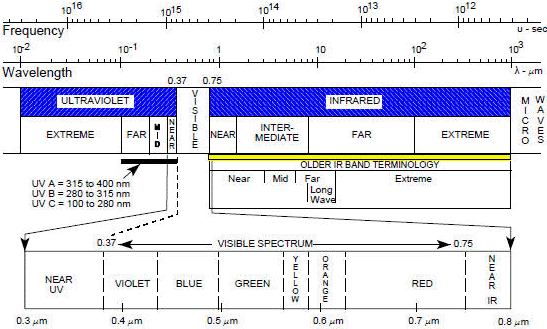
Figure
1. Optical Spectrum

Figure 2. Electromagnetic Radiation Spectrum
TERMINOLOGY The common terms used to describe optical radiation are the source parameters of power, radiant
emittance (older term) or radiant existence (newer term), radiance, and radiant intensity. They refer to how much radiation is given off by
a body. The parameter measured by the detector (or collecting object/surface) is the irradiance. Any of these quantities can be expressed per
unit wavelength in which case the subscript is changed from e (meaning energy derived units) to λ and the term is then called "Spectral ...X...",
i.e. Ie is radiant intensity, while Iλ is spectral radiant intensity. These quantities in terms of currently preferred
“Système International d'Unités” (SI units) are defined in Table 1.
Table 1. Radiometric SI Units. 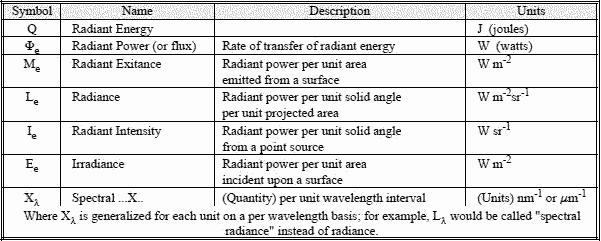
In common usage, irradiance is expressed in units of watts per square centimeter and wavelengths are in μm instead of nanometers (nm).
These previously accepted units and the formerly used symbols are known as the Working Group on Infrared Background (WGIRB) units, and are shown
in Table 2. The radiant intensity is in watts per steradian in both systems.
Table 2. Older WGIRB Radiometric Units. 
Other radiometric definitions are shown in Table 3.
Table 3. Other Radiometric Definitions 
Where (*) represents the appropriate quantity Q, Ψ, M, E, or L Note (1) Radiant absorptance should not
be confused with absorption coefficient. The processes of absorption, reflection (including scattering), and transmission account for
all incident radiation in any particular situation, and the total must add up to one: a + ρ + τ = 1, as shown in
Figure 3. 
A few words may be needed about the unit of solid angle, the steradian. Occasionally this unit is confusing
when it is first encountered. This confusion may be partly due to difficulty in visualization and partly due to steradian being apparently a
dimensionless unit (which is in itself a contradiction). Three solid angles are easy to visualize - these are the sphere, the hemisphere, and
the corner of a cube (see Figure 4). There are 4π steradians surrounding the center of a sphere, 2π steradians in a hemisphere, and ½ π steradians in the corner of a cube (that is, the solid
angle subtended by two walls and the floor of a room is ½ π steradians).
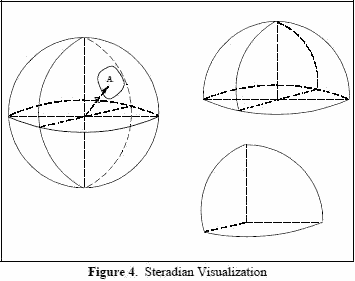 The problem of
dimensions enters in calculating the steradiancy of a given area on a spherical surface. The number of steradians intercepted by an area A on
the surface of a sphere of radius R is A/R2. If length is measured in centimeters, the dimensions of the solid angle is cm2/cm2.
So, steradian appears to be dimensionless. However, it is the unit, steradian, that is dimensionless (in terms of units of length), not the
solid angle itself. One steradian is the solid angle intercepted by an area of one square centimeter on a spherical surface of one centimeter
radius (or one square foot at one foot). The problem of
dimensions enters in calculating the steradiancy of a given area on a spherical surface. The number of steradians intercepted by an area A on
the surface of a sphere of radius R is A/R2. If length is measured in centimeters, the dimensions of the solid angle is cm2/cm2.
So, steradian appears to be dimensionless. However, it is the unit, steradian, that is dimensionless (in terms of units of length), not the
solid angle itself. One steradian is the solid angle intercepted by an area of one square centimeter on a spherical surface of one centimeter
radius (or one square foot at one foot). IR wavelengths are typically expressed in μm, visible wavelengths in μm or nm, and UV wavelengths
in nm or angstroms. Table 4 lists conversion factors for converting from one unit of wavelength to another. The conversion is from column to
row. For example, to convert from μm to nm, multiply the value expressed in μm by 103. IR wavelengths are also sometimes expressed in a frequency-like
unit called wavenumbers or inverse centimeters. A wavenumber value can be found by dividing 10,000 by the wavelength expressed in μm. For example,
2.5 μm converts to a wavenumber of 4000 or 4000 inverse centimeters (cm-1).
Table 4. Wavelength Conversion Units 
PHOTOMETRIC QUANTITIES Whereas the radiometric quantities Ψe, Me, Ie, Le,
and Ee have meaning throughout the entire electromagnetic spectrum, their photometric counterparts Ψv, Mv,
Iv, Lv, and Ev are meaningful only in the visible spectrum (0.38 μm thru 0.78 μm). The standard candle has been
redefined as the new candle or candela (cd). One candela is the luminous intensity of 1/60th of 1 cm2 of the projected area of a blackbody radiator
operating at the temperature of the solidification of platinum (2045 ºK). The candela (by definition) emits one lumen (lm) per steradian.
Table 5 displays the photometric quantities and units. These are used in dealing with optical systems such as aircraft television camera
systems, optical trackers, or video recording.
Table 5. Photometric SI Units. 
Table 6 displays conversion factors for commonly used illuminance quantities.
Table 6. Illuminance Conversion Units 
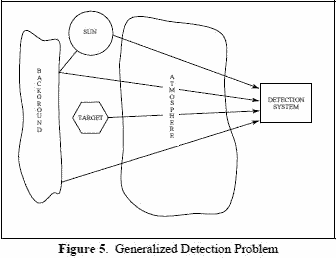 GENERALIZED DETECTION PROBLEM GENERALIZED DETECTION PROBLEM
Figure 5 shows a generalized detection problem. On
the left of the diagram are the radiation sources - the sun, background, and the target of interest. In the middle is the intervening atmosphere,
which attenuates the radiation as it travels to the detection system shown on the right of the diagram. Anything at temperatures above
absolute zero radiates energy in the electromagnetic spectrum. This radiation is a product of molecular motion, and the spectral distribution
of the radiation is characterized by the temperature of the body. The four basic laws of IR radiation are Kirchhoff's law, Planck's law, the
Stefan-Boltzmann law, and Lambert's cosine law. Kirchhoff found that a material that is a good absorber of radiation is also a good radiator.
Kirchhoff's law states that the ratio of radiated power and the absorption coefficient: (1) is the same for all radiators at that temperature,
(2) is dependent on wavelength and temperature, and (3) is independent of the shape or material of the radiator. If a body absorbs all radiation
falling upon it, it is said to be "black." For a blackbody the radiated power is equal to the absorbed power, and the emissivity (ratio of emitted
power to absorbed power) equals one. One can also have a graybody - one which emits with the spectral distribution of a blackbody but at a lower
intensity level because it has an emissivity of something less than one. The radiation from a blackbody at a specific wavelength can
be calculated from Planck's law:

Figure 6 shows the spectral radiant emittance of blackbody radiators at several temperatures as calculated from this equation. [Wλ
is in W/cm3 so multiply by 10 to get W/cm2 micron]. Wein's displacement law takes the derivative of the Plank's
law equation (above) to find the wavelength for maximum spectral exitance (emittance) at any given temperature (or the temperature of maximum
output at a given wavelength): λm T = 2897.8 μ°K For example, given that T=568ºK, then λm
= 5.1μ as verified by examining Figure 6.

Figure 6. Blackbody Spectral Radiant Emittance
According to the Stefan-Boltzmann law, the total radiant emittance of a blackbody is proportional to the fourth power of the temperature:

This is Plank's radiation law integrated over all values of λ. 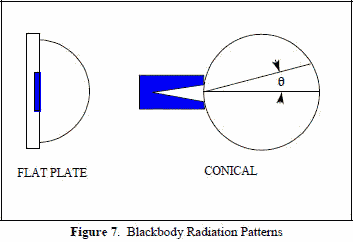 A blackbody is a perfectly diffuse radiator. According to Lambert's
law of cosines, the radiation emitted by a perfectly diffuse radiator varies as the cosine of the angle between the line of sight and the normal
to the surface. As a consequence of Lambert's law, the radiance of a blackbody cavity is 1/π times the radiant emittance
(a conical blackbody cavity emits into a solid angle of π steradians). The radiation from a flat plate is emitted
into 2π steradians. The radiation pattern for these sources are shown in Figure 7. Notice that the conical cavity
has the highest radiation straight ahead, and nothing at 2 angles approaching 90º whereas the flat plate has a uniform radiation pattern at
all angles in front of the surface. A blackbody is a perfectly diffuse radiator. According to Lambert's
law of cosines, the radiation emitted by a perfectly diffuse radiator varies as the cosine of the angle between the line of sight and the normal
to the surface. As a consequence of Lambert's law, the radiance of a blackbody cavity is 1/π times the radiant emittance
(a conical blackbody cavity emits into a solid angle of π steradians). The radiation from a flat plate is emitted
into 2π steradians. The radiation pattern for these sources are shown in Figure 7. Notice that the conical cavity
has the highest radiation straight ahead, and nothing at 2 angles approaching 90º whereas the flat plate has a uniform radiation pattern at
all angles in front of the surface.
The interrelationship of the various quantities that describe source and received radiation
in a vacuum are:

In actual practice the intervening atmosphere attenuates the radiation passing from the source to the receiver. When atmospheric
transmission is accounted for, the receiver equation becomes: Ee = τIe/D2
where τ is the atmospheric transmittance. The sources of radiation encountered outside the laboratory
are either targets or backgrounds. One person's target may be another person's background. The target is the radiation source of interest -
for example, an aircraft, a missile, a structure on the ground, or a ship at sea. The backgrounds are the non-target sources included within
the field of view of the detection system which produce what amounts to noise - background noise. Possible background sources include the sun,
clouds, terrain, the sea, blue sky, night sky, and stars. Figure 8 shows the spectral distribution of radiation from several targets and background
sources. Spectral and spatial means are generally used to discriminate the target from the background. Spectral discrimination can be used because
the targets are often characterized by spectral line or band emissions which yield a high signal to background ratio within a selected wavelength
band. Also the target is usually small compared to the background so spatial discrimination can be used.

NOTE: These charts show relative not absolute radiant intensity of each signature. Consequently
the "amplitude" of one cannot be compared with the "amplitude" of another.
Figure 8. Spectral Distribution of Various Targets
ATMOSPHERIC TRANSMISSION The radiation emitted or reflected from the targets and backgrounds must pass through
the intervening atmosphere before reaching the detection system. The radiation is absorbed and re-emitted by molecular constituents of the atmosphere
and scattered into and out of the path by various aerosol components. In the IR, atmospheric attenuation follows an exponential relationship
expressed by the following equation: I = Io-kD, where Io is the radiation incident on the attenuating medium,
k is the extinction coefficient, and D is the path length. The molecules that account for most of the absorption in the IR region are
water, carbon dioxide, nitrous oxide, ozone, carbon monoxide, and methane. Figure 9 shows the transmission of radiation over a 1 NM level path.
The curve shows absorptions due to: 1) both water and carbon dioxide at 1.4 μm, 1.85 μm, and 2.7 μm; 2) due to water only at 6 μm; and 3) due
to carbon dioxide only at 4.3 μm. Inspection of Figure 9 reveals the presence of atmospheric windows, i.e. regions of reduced atmospheric
attenuation. IR detection systems are designed to operate in these windows. Combinations of detectors and spectral bandpass filters are selected
to define the operating region to conform to a window to maximize performance and minimize background contributions. Figure 10 shows an expanded
view of the infrared portion of the spectrum. The transmission in a window is greatly dependent on the length and characteristics of
the path. Figure 11 shows the transmission for a 15 NM path at 10,000-foot altitude with 100% relative humidity. As is readily apparent, the
transmission in the windows is greatly reduced over the longer path compared to the transmission for the shorter path shown in Figure 9. Since
water vapor generally decreases with altitude, transmission generally increases and path length becomes the determining factor. However, path
length does not affect transmission of all wavelengths the same.
ATTENUATION OF EM WAVES BY THE ATMOSPHERE

Figure 9. Atmospheric Transmission Over 1 NM Sea Level Path
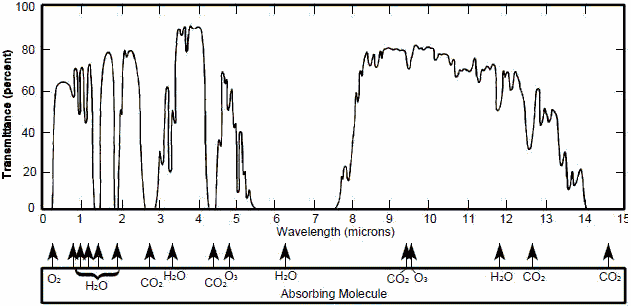
Figure 10. Transmittance of Atmosphere Over 1 NM Sea Level Path (Infrared
Region)
 DETECTORS DETECTORS
A detector is a transducer which transforms electromagnetic radiation into a form which can be more easily detected. In the detectors of
interest to EW the electromagnetic radiation is converted into an electrical signal. In some systems the signal is processed entirely within
the system to perform its function. In others the signal is converted to a form to allow the human eye to be used for the final detection and
signal analysis. Detection Mechanisms The physical effects by which electromagnetic radiation is
converted to electrical energy are divided into two categories: photon effects and thermal effects. EW systems primarily use detectors dependent
on photon effects. These effects can be divided into internal photo effects and external photo effects. The external photo effect is known as
photoemission. In the photoemissive effect, photons impinging on a photocathode drive electrons from its surface. These electrons may then be
collected by an external electrode and the photocurrent thus obtained is a measure of the intensity of the received radiation. Internal
photoeffects of interest are the photoconductive effect and the photovoltaic effect. In the photoconductive effect, absorbed photons cause an
increase in the conductivity of a semiconductor. The change is detected as a decrease in the resistance in an electrical circuit. In the photovoltaic
effect, absorbed photons excite electrons to produce a small potential difference across a p-n junction in the semiconductor. The photovoltage
thus produced may be amplified by suitable electronics and measured directly.
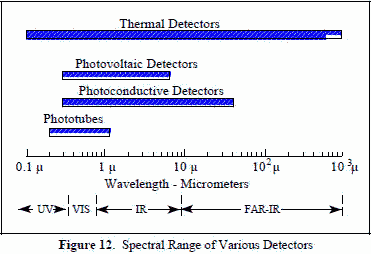 The
pyroelectric effect is a thermal effect that is applicable to EW systems. The pyroelectric effect is a change in polarization in a crystal due
to changes in temperature. Radiation falling on such a crystal is detected by observing the change in polarization as a build up of surface
charge due to local heating. When coated with a good black absorber, the crystal will be sensitive to a wide band of wavelengths. The
pyroelectric effect is a thermal effect that is applicable to EW systems. The pyroelectric effect is a change in polarization in a crystal due
to changes in temperature. Radiation falling on such a crystal is detected by observing the change in polarization as a build up of surface
charge due to local heating. When coated with a good black absorber, the crystal will be sensitive to a wide band of wavelengths. Figure
12 shows the spectral sensitivity range of typical detectors using these effects. Detector Types
Photon detectors exhibit sharp long wavelength cutoffs. The principle photoemissive detector type in EW systems is the photomultiplier.
Current amplification is obtained in photomultipliers by secondary emission. A series of electrodes known as dynodes lie between the cathode
and the anode. The structure of side-on and end-on type photomultipliers is shown in Figure 13. The photoelectrons from the cathode are
accelerated and focused onto the first dynode. Secondary electrons from the first dynode are accelerated and focused onto the second dynode,
which emits more secondaries. This process is continued through from 4 to 16 stages in commercial tubes. Current gains of 10 million can be
obtained with 16 stages. Typical response times (electron transit time) are tens of nanoseconds.

Figure 13. Multiplier Phototubes
Photoconductive detectors consist of a body of semiconductor - single or arrays- having electrodes attached to opposite ends. In operation they
are used in electronic circuits as resistors whose resistance depends on the radiation upon the sensitive surface. Typical cooled and uncooled
configurations are shown in Figure 14.
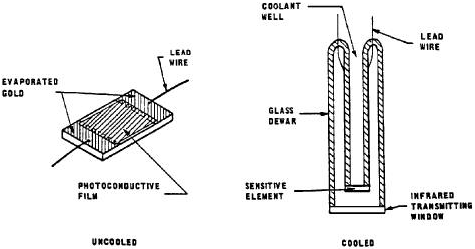
Figure 14. Photoconductive Detector
Photovoltaic detector configurations are shown in Figure 15. Photoconductive and photovoltaic detectors in EW systems are usually operated cooled
for greater sensitivity. N-type material contains a large number of excess electrons and few “holes”, while P-type material contains few electrons
and many holes.

Figure 15. Photovoltaic Detector Configurations Diode phototubes and photomultipliers are commonly used detectors for UV systems. The typical IR system uses arrays of photoconductive or photovoltaic
detectors. Many state-of-the-art IR systems use what is known as focal plane arrays. The advantage of focal plane detectors is the ability to
integrate processing electronics elements right on the same chip as the detector elements. Most visible band systems of interest are televisions.
An example of a typical television camera tube is the vidicon (Figure 16). The vidicon is a storage type camera tube in which a charge-density
pattern is formed by the imaged scene radiation on a photoconductive surface which is then scanned by a beam of low velocity electrons. The
fluctuating voltage coupled out to a video amplifier can be used to reproduce the scene being imaged. Pyroelectric photocathodes can be used
to produce a vidicon sensitive over a broad portion of the IR.
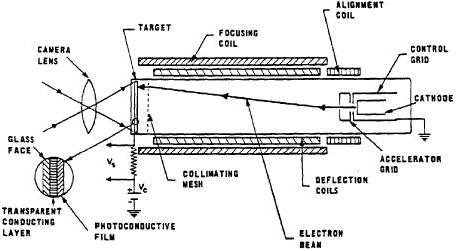
Figure 16. Vidicon
Another type of camera tube is the image orthicon which uses a photoemissive sensitive element (Figure 17). Small, light weight television
cameras can now be made using charge-coupled device (CCD) or charge-injection device (CID) technology. CCD cameras are the basis of the popular
hand-held camcorders.
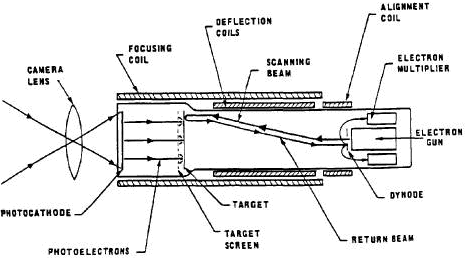
Figure
17. Image Orthicon The most common detectors used in surface-to-air and air-to-air missile seekers use compounds which include: Cadmium Sulfide
- CdS Lead Selenide - PbSe Gallium Arsenide - GaAs
Lead Sulfide - PbS Indium Antimonide - InSb Other known detector material includes: Germanium doped with Copper - Ge:Cu
Germanium doped with Zinc - Ge:Zn Germanium doped with Gold - Ge:Au
Indium Arsenide - InAs Germanium doped with Mercury - Ge:Hg Lead
Telluride - PbTe Mercury Cadmium Telluride - HgCdTe Some detectors (such as InSb) have multiple modes of operation, including:
Photoconductive (PC), Photovoltaic (PV), or Photoelectromagnetic (PEM) modes of operation. Typical spectral detectivity characteristics for
various detectors are shown in Figure 18. Detector Parameters and Figures of Merit The important
parameters in evaluating a detector are the spectral response, time constant, the sensitivity, and the noise figure. The spectral response determines
the portion of the spectrum to which the detector is sensitive. The time constant is a measure of the speed of response of the detector. It
is also indicative of the ability of the detector to respond to modulated radiation. When the modulation frequency is equal to one over the
time constant, the response has fallen to 70.7 % of the maximum value. The time constant is related to the lifetime of free carriers in photoconductive
and photovoltaic detectors and to the thermal coefficient of thermal detectors. The time constant in photoemissive devices is proportional to
the transit time of photoelectrons between the photocathode and anode.

Figure 18. Spectral Detectivity of Various Detectors The sensitivity of a detector is related to its responsivity. The responsivity is the ratio of the detected signal output to the radiant
power input. For photoconductive and photovoltaic detectors the responsivity is usually measured in volts per watt -- more correctly, RMS volts
per RMS watt. However, the sensitivity of a detector is limited by detector noise. Responsivity, by itself, is not a measure of sensitivity.
Detector sensitivity is indicated by various figures of merit, which are analogous to the minimum detectable signal in radar. Such a quantity
is the noise equivalent power (NEP). The NEP is a measure of the minimum power that can be detected. It is the incident power in unit bandwidth
which will produce a signal voltage equal to the noise voltage. That is, it is the power required to produce a signal-to-noise ratio of one
when detector noise is referred to unit bandwidth. The units of NEP are usually given as watts, but, more correctly, are watts/Hz½
or watts·sec½. Another figure of merit is the noise equivalent input (NEI). The NEI is defined as the radiant power per unit
area of the detector required to produce a signal-to-noise ratio of one. The NEI is obtained by dividing the NEP by the sensitive area of the
detector. The units of NEI are watts per square centimeter. An NEI for photoemissive devices is commonly given in lumens. The NEP has
the disadvantage that better detectors have smaller NEP's, but the human psyche is such that a figure of merit that increases for improvements
in detector performance is preferable. A figure of merit which has that feature is the detectivity (D), which is defined as the reciprocal of
the NEP. The units of D are watts-1·sec-½. A higher value of detectivity indicates an improvement in detection capability.
The dependence on detector area is removed in another detectivity measure, known as D-star (D*). D* is the detectivity measured with a bandwidth
of one hertz and reduced to a responsive area of one square centimeter. The units of D* are cm·watts-1·sec-½. D* is the
detectivity usually given in detector specification sheets. The spectral detectivity is the parameter used in Figure 18. Besides the
NEI mentioned above, the quantum efficiency of the photocathode is also a figure of merit for photoemissive devices. Quantum efficiency is expressed
as a percent -- the ratio of the number of photoelectrons emitted per quantum of received energy expressed as a percent. A quantum efficiency
of 100 percent means that one photoelectron is emitted for each incident photon. There are other figures of merit for television cameras.
The picture resolution is usually described as the ability to distinguish parallel black and white lines and is expressed as the number of line
pairs per millimeter or TV lines per picture height. The number of pixels in the scene also defines the quality of an image. A pixel, or picture
element, is a spatial resolution element and is the smallest distinguishable and resolvable area in an image. CCD cameras with 512 x 512 elements
are common. Another resolution quantity is the gray scale, which is the number of brightness levels between black and white a pixel can have.
Noise in Detectors The performance of a detector is limited by noise. The noise is the random currents
and voltages which compete with or obscure the signal or information content of the radiation. Five types of noise are most prominent in detectors:
thermal, temperature, shot, generation-recombination, and 1/f noise. Thermal noise, also known as Johnson noise or Nyquist noise, is electrical
noise due to random motions of charge carriers in a resistive material. Temperature noise arises from radiative or conductive exchange between
the detector and its surroundings, the noise being produced by fluctuations in the temperature of the surroundings. Temperature noise is prominent
in thermal detectors. Shot noise occurs due to the discreetness of the electronic charge. In a photoemissive detector shot noise is due to thermionic
emission from the photocathode. Shot noise also occurs in photodiodes and is due to fluctuations in the current through the junction. Generation-recombination
noise is due to the random generation and recombination of charge carriers (holes and electrons) in semiconductors. When the fluctuations are
caused by the random arrival of photons impinging upon the detector, it is called photon noise. When it is due to interactions with phonons
(quantized lattice vibrations), it is called generation-recombination noise. Johnson noise is predominant at high frequencies, shot noise predominates
at low frequencies, and generation-recombination and photon noise are predominant at intermediate frequencies. As the name implies, 1/f noise
has a power spectrum which is inversely proportional to frequency. It is dominant at very low frequencies. In photoemissive detectors it is
called flicker noise and has been attributed to variation in the emission from patches of the photocathode surface due to variation in the work
function of the surface. In semiconductors 1/f noise is also called modulation noise. Here it is apparently due to surface imperfections and
ohmic contacts (which are a form of surface imperfection). LASERS The word laser comes from Light Amplification
by Stimulated Emission of Radiation. The lasing medium may be a solid, a gas, or a liquid. Lasing action has been achieved using atoms, ions,
and molecules. The emission may be pulsed or CW. Figure 19 shows the spectral output of several laser types. The first laser was
a pulsed, solid state laser, the ruby laser. In the ruby laser a xenon flash lamp is used to excite the atoms in a ruby rod to higher energy
levels. The highly polished and mirrored ends of the rod form a resonant cavity. One end of the rod has a slightly lower reflectivity. The lamp
excitation produces an inverted population of excited atoms which are stimulated to relax to lower energy levels releasing their extra energy
as photons. Repeated reflections off the mirrored ends of the rod causes the photons to bounce back and forth through the rod stimulating further
emissions at the same wavelength and phase producing a highly coherent beam which finally passes through the lower reflectivity end.
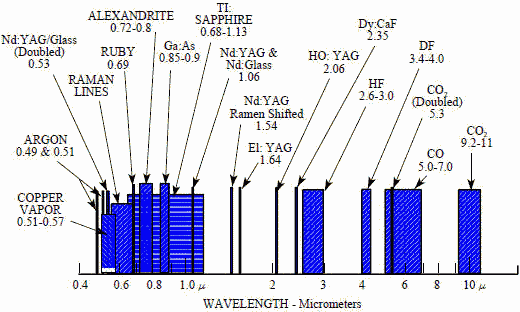
Figure 19. Spectral Lines / Ranges of Available Lasers Figure 20 is a schematic representation of a ruby laser. The typical laser rangefinder uses a solid state laser with a neodymium-YAG
crystal lasing at 1.06 μm.
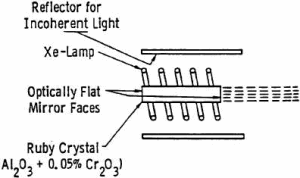
Figure 21.
Gas Laser Gas lasers are of several kinds and can be pulsed or CW. The gas dynamic laser obtains its inverted population through a rapid temperature
rise produced by accelerating the gas through a supersonic nozzle. In chemical lasers the inversion is produced by a chemical reaction. In the
electric discharge laser the lasing medium is electrically pumped. The gas can also be optically pumped. In an optically pumped gas laser the
lasing medium is contained in a transparent cylinder. The cylinder is in a resonant cavity formed by two highly reflective mirrors. The typical
configuration is shown in Figure 21.
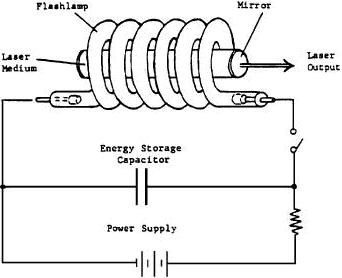
Figure 21.
Gas Laser Many gas lasers use carbon dioxide as the lasing medium (actually a mixture of CO2 and other gases). These are the basis for most high
energy or high power lasers. The first gas laser was an optically pumped CW helium-neon laser. The common laser pointer is a helium-neon laser
operating at 0.6328 μm. The lasing medium is a mixture of helium and neon gas in a gas discharge or plasma tube as shown in Figure 22.

Figure
22. Helium-Neon Laser The dye laser is an example of a laser using a liquid for the lasing medium. The lasing medium is an organic dye dissolved in a solvent such
as ethyl alcohol. Dye lasers operate from the near UV to the near IR, are optically pumped, and are tunable over a fairly wide wavelength range.
 Mention should also be
made of semiconductor or injection lasers, also known as laser diodes. The junctions of most semiconductor diodes will emit some radiation if
the devices are forward biased. This radiation is the result of energy released when electrons and holes recombine in the junction. There are
two kinds of semiconductor diode emitters: (1) the light emitting diode (LED), which produces incoherent spontaneous emission when forward biased
and which has a broad (800 angstrom) spectral output, and (2) the laser diode, which maintains a coherent emission when pulsed beyond a threshold
current and which has a narrow spectral width (< 10 angstrom). In the laser diode the end faces of the junction region are polished to form
mirror surfaces. They can operate CW at room temperatures, but pulsed operation is more common. Figure 23 shows a typical diode laser structure. Mention should also be
made of semiconductor or injection lasers, also known as laser diodes. The junctions of most semiconductor diodes will emit some radiation if
the devices are forward biased. This radiation is the result of energy released when electrons and holes recombine in the junction. There are
two kinds of semiconductor diode emitters: (1) the light emitting diode (LED), which produces incoherent spontaneous emission when forward biased
and which has a broad (800 angstrom) spectral output, and (2) the laser diode, which maintains a coherent emission when pulsed beyond a threshold
current and which has a narrow spectral width (< 10 angstrom). In the laser diode the end faces of the junction region are polished to form
mirror surfaces. They can operate CW at room temperatures, but pulsed operation is more common. Figure 23 shows a typical diode laser structure.
Q-switching is a means of obtaining short intense pulses from lasers. The Q-switch inhibits lasing until a very large inverted population
builds up. The switch can be active or passive. A passive Q-switch switches at a predetermined level. An active Q-switch is controlled by external
timing circuits or mechanical motion. The switch is placed between the rod (or lasing medium) and the 100 percent mirror. Figure 24 shows an
arrangement using a Pockels cell as an active Q-switch.

Figure 24. Q-switch Arrangement FIBER OPTICS Fiber optic cables are the optical analogue of RF waveguides. Transmission of radiation through an
optical fiber is due to total internal reflection of the radiation from the walls of the fiber. A plain fiber has leakage through the walls.
This is controlled by coating, or cladding, the fiber with a lower refractive index material. Fibers with the best transmission characteristics
(lowest attenuation) operate in the near infrared (out to 1.7 μm). Typical attenuations vary from two to ten dB/km in the visible to 0.2 to
0.5 dB/km in the near infrared. Developmental fibers for use in the 2 to 20 μm wavelength range have attenuations of hundreds of dBs/km.
Optical fibers are not used in any current EO systems. Potential applications include use with smart skins where radiation is collected
on the skin and piped by fiber optics to detectors elsewhere in the aircraft. Use of fiber optics in a high speed data bus for EW systems will
probably come first. ELECTRO-OPTICAL SYSTEMS A basic EO system is composed of an optical head, an electronics
package, and an output unit. The optical head consists of a window, collecting optics which gathers the incident radiation and focusses it on
the detector, a field stop to define the field of view, a reticle or chopper to modulate and encode the radiation, optical filters to define
the wavelength region of response, a detector to convert the incident radiation into an electrical signal, and a preamplifier to increase the
signal level from the detector before further handling or processing. The system electronics consist of amplifiers, signal processors, and system
controls. The output unit consists of indicators or displays. Windows/Domes For most applications
of EO systems in EW the detection system is protected from the environment by a window or dome of optically transmissive material. The window
operates both as a weather seal and, in some cases, helps to define the spectral response region of the system. The transmission bands of a
representative sample of window materials is shown in Figure 25. The end points given are for the 10 percent transmission wavelengths. Not shown
in Figure 25 are the various UV transmissive glasses such as Pyrex, Corex, and Vycor.

Figure 25. Transmission of Selected Window Materials
Optical Filters Most optical radiation detectors have a wider sensitivity band than desired for the
particular application. To further define the system sensitivity, band interference filters or absorption filters are used. An absorption filter
is a bulk material with a sharp cut-on or cut-off in its transmission characteristic. A cut-on and a cut-off filter can be combined to make
a bandpass filter. By selecting absorption characteristics of absorption filters combined with the response of a detector, the desired system
response can be obtained. An interference filter is composed of dielectric coatings on an appropriate substrate combined in such a way to produced
cut-on, cut-off, or bandpass filters. Interference filters allow more control of the final response characteristics and smaller elements.
Besides bandpass filters, EO system optics often have antireflection (or AR) coatings to eliminate or greatly reduce unwanted reflections
between optical elements. Detector Coolers
Many IR detectors have to be cooled for
proper operation. Most systems use closed-cycle coolers or thermoelectric coolers. Thermoelectric coolers use the Peltier effect, which produces
a reduced temperature by passing a d-c current through a thermoelectric junction. Multi-stage coolers can cool a detector down to below 200ºK.
Closed-cycle coolers typically are of the Stirling cycle design and utilize the expansion of a gas (helium) to cool a cold finger attached to
the detector. These generally operate at liquid nitrogen temperature (77ºK). Displays Imaging systems
such Forward Looking Infrared (FLIR) systems use cathode ray tubes (CRTs) to display their output. Future EW systems may incorporate flat panel
displays of some type. Possible types are liquid crystal displays (LCDs), LED arrays, or gas plasma displays.
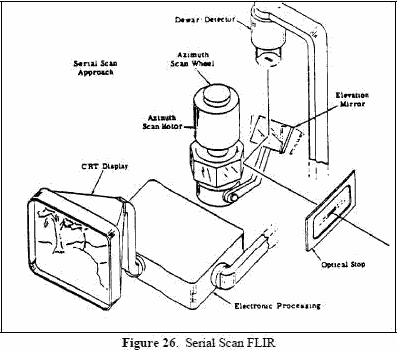 Types
of Systems Types
of Systems EO systems of interest to EW include the following: FLIR systems - A passive thermal imager which typically
uses the emitted radiation of a target in the 8 to 14 μm atmospheric window to produce a picture of the scene. Figure 26 shows the configuration
of a typical FLIR using the serial scan approach. A FLIR could be used with a 10.6 μm laser target designator to determine if the proper target
is being illuminated. Infrared Search and Track Systems (IRSTS) - The IRSTS is an EO analogue of a radar system. A focal plane array
detector is scanned across the field of regard, and the locations of detected targets are displayed on a CRT. Although without direct range
measuring capability, triangulation techniques can be used for passive ranging. If combined with a laser rangefinder, an IRSTS could function
just like an optical radar. An IRST provides better angular resolution but poorer range accuracy than a RF radar system. Missile Warning
Receivers/Sets - These may have either scanning or staring optical systems to detect and process the radiation from missile motors and alert
the pilot that the aircraft is under attack. Laser Warning Sets - These typically have staring optics. They detect and process received
laser radiation. The pilot is alerted of the type and the direction of the laser detected. Infrared Countermeasure (IRCM) Systems - The
EO analogue of RF jammers. They radiate a modulated IR signal designed to confuse the detection/tracking system of an attacking IR guided missile
and cause it to miss. Television Camera Sets - High resolution TV camera systems primarily used for the identification friend or foe
application. Laser Rangefinders - A laser coupled with timing circuits to measure time of travel of laser pulses to and from a target.
They can give very accurate ranges. Laser Target Designators - Laser systems used to illuminate targets being attacked by laser guided
munitions.
Table of Contents for Electronics Warfare and Radar Engineering Handbook
Introduction |
Abbreviations | Decibel | Duty
Cycle | Doppler Shift | Radar Horizon / Line
of Sight | Propagation Time / Resolution | Modulation
| Transforms / Wavelets | Antenna Introduction
/ Basics | Polarization | Radiation Patterns |
Frequency / Phase Effects of Antennas |
Antenna Near Field | Radiation Hazards |
Power Density | One-Way Radar Equation / RF Propagation
| Two-Way Radar Equation (Monostatic) |
Alternate Two-Way Radar Equation |
Two-Way Radar Equation (Bistatic) |
Jamming to Signal (J/S) Ratio - Constant Power [Saturated] Jamming
| Support Jamming | Radar Cross Section (RCS) |
Emission Control (EMCON) | RF Atmospheric
Absorption / Ducting | Receiver Sensitivity / Noise |
Receiver Types and Characteristics |
General Radar Display Types |
IFF - Identification - Friend or Foe | Receiver
Tests | Signal Sorting Methods and Direction Finding |
Voltage Standing Wave Ratio (VSWR) / Reflection Coefficient / Return
Loss / Mismatch Loss | Microwave Coaxial Connectors |
Power Dividers/Combiner and Directional Couplers |
Attenuators / Filters / DC Blocks |
Terminations / Dummy Loads | Circulators
and Diplexers | Mixers and Frequency Discriminators |
Detectors | Microwave Measurements |
Microwave Waveguides and Coaxial Cable |
Electro-Optics | Laser Safety |
Mach Number and Airspeed vs. Altitude Mach Number |
EMP/ Aircraft Dimensions | Data Busses | RS-232 Interface
| RS-422 Balanced Voltage Interface | RS-485 Interface |
IEEE-488 Interface Bus (HP-IB/GP-IB) | MIL-STD-1553 &
1773 Data Bus | This HTML version may be printed but not reproduced on websites.
|













 The problem of
dimensions enters in calculating the steradiancy of a given area on a spherical surface. The number of steradians intercepted by an area A on
the surface of a sphere of radius R is A/R2. If length is measured in centimeters, the dimensions of the solid angle is cm2/cm2.
So, steradian appears to be dimensionless. However, it is the unit, steradian, that is dimensionless (in terms of units of length), not the
solid angle itself. One steradian is the solid angle intercepted by an area of one square centimeter on a spherical surface of one centimeter
radius (or one square foot at one foot).
The problem of
dimensions enters in calculating the steradiancy of a given area on a spherical surface. The number of steradians intercepted by an area A on
the surface of a sphere of radius R is A/R2. If length is measured in centimeters, the dimensions of the solid angle is cm2/cm2.
So, steradian appears to be dimensionless. However, it is the unit, steradian, that is dimensionless (in terms of units of length), not the
solid angle itself. One steradian is the solid angle intercepted by an area of one square centimeter on a spherical surface of one centimeter
radius (or one square foot at one foot).


 GENERALIZED DETECTION PROBLEM
GENERALIZED DETECTION PROBLEM


 A blackbody is a perfectly diffuse radiator. According to Lambert's
law of cosines, the radiation emitted by a perfectly diffuse radiator varies as the cosine of the angle between the line of sight and the normal
to the surface. As a consequence of Lambert's law, the radiance of a blackbody cavity is 1/
A blackbody is a perfectly diffuse radiator. According to Lambert's
law of cosines, the radiation emitted by a perfectly diffuse radiator varies as the cosine of the angle between the line of sight and the normal
to the surface. As a consequence of Lambert's law, the radiance of a blackbody cavity is 1/



 DETECTORS
DETECTORS The
pyroelectric effect is a thermal effect that is applicable to EW systems. The pyroelectric effect is a change in polarization in a crystal due
to changes in temperature. Radiation falling on such a crystal is detected by observing the change in polarization as a build up of surface
charge due to local heating. When coated with a good black absorber, the crystal will be sensitive to a wide band of wavelengths.
The
pyroelectric effect is a thermal effect that is applicable to EW systems. The pyroelectric effect is a change in polarization in a crystal due
to changes in temperature. Radiation falling on such a crystal is detected by observing the change in polarization as a build up of surface
charge due to local heating. When coated with a good black absorber, the crystal will be sensitive to a wide band of wavelengths.









 Mention should also be
made of semiconductor or injection lasers, also known as laser diodes. The junctions of most semiconductor diodes will emit some radiation if
the devices are forward biased. This radiation is the result of energy released when electrons and holes recombine in the junction. There are
two kinds of semiconductor diode emitters: (1) the light emitting diode (LED), which produces incoherent spontaneous emission when forward biased
and which has a broad (800 angstrom) spectral output, and (2) the laser diode, which maintains a coherent emission when pulsed beyond a threshold
current and which has a narrow spectral width (< 10 angstrom). In the laser diode the end faces of the junction region are polished to form
mirror surfaces. They can operate CW at room temperatures, but pulsed operation is more common. Figure 23 shows a typical diode laser structure.
Mention should also be
made of semiconductor or injection lasers, also known as laser diodes. The junctions of most semiconductor diodes will emit some radiation if
the devices are forward biased. This radiation is the result of energy released when electrons and holes recombine in the junction. There are
two kinds of semiconductor diode emitters: (1) the light emitting diode (LED), which produces incoherent spontaneous emission when forward biased
and which has a broad (800 angstrom) spectral output, and (2) the laser diode, which maintains a coherent emission when pulsed beyond a threshold
current and which has a narrow spectral width (< 10 angstrom). In the laser diode the end faces of the junction region are polished to form
mirror surfaces. They can operate CW at room temperatures, but pulsed operation is more common. Figure 23 shows a typical diode laser structure.


